window OLDSMOBILE BRAVADA 1998 Owner's Manual
[x] Cancel search | Manufacturer: OLDSMOBILE, Model Year: 1998, Model line: BRAVADA, Model: OLDSMOBILE BRAVADA 1998Pages: 380, PDF Size: 19.2 MB
Page 193 of 380
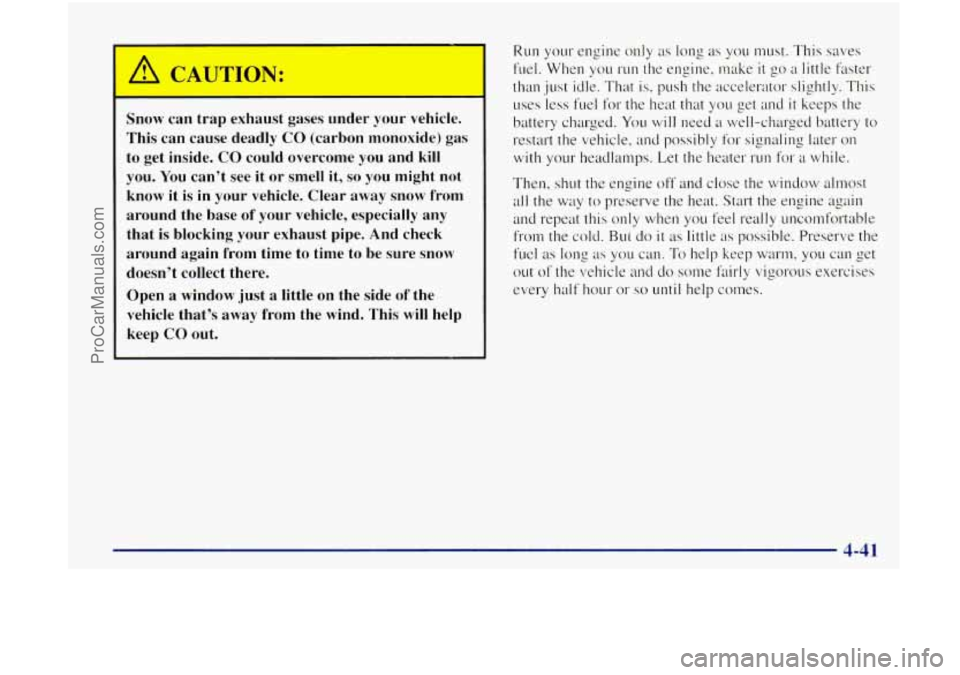
I
A CP ""IC\:
Snow can trap exhaust gases under your vehicle.
This can cause deadly CO (carbon monoxide) gas
to get inside.
CO could overcome you and kill
you. You can't see it or smell it,
so you might not
know it is
in your vehicle. Clear away snow from
around the base of your vehicle, especially any
that is blocking your exhaust pipe. And check
around again from time to time to be sure snow
doesn't collect there.
Open
a window just a little on the side of the
vehicle that's away from the wind. This
will help
keep CO out.
Run your engine only as long as you must. This saves
fuel. When you run the engine. make it go a little faster
than just idle. That is, push the accelerator slightly. This
uses less fuel for
the heat that you get and it keeps the
battery charged. You will need
a we.11-charged battery to
restart the vehicle. and possibly
for signaling later on
with your headlamps. Let the heater run for a while.
Then, shut the engine off and
close the window almost
all the way to preserve the heat. Start the engine again
and repeat this only when you feel really uncornfortable
from the
cold. BLI~ do it as little as possible. Preserve the
fuel
as long as you can. To help keep warm, you can get
out
of the vehicle and do some fairly vigorous exercises
every half hour or
so until help comes.
ProCarManuals.com
Page 201 of 380

Driving with a Trailer
If you have a rear-most window open and you
pull
a trailer with your vehicle, carbon monoxide
(CO) could come into your vehicle. You can’t see
or smell CO. It can cause unconsciousness or
death. (See “Engine Exhaust”
in the Index.) To
maximize your safety when towing a trailer:
Have your exhaust system inspected for leaks,
and make necessary repairs before
starting on your trip.
Keep the rear-most windows closed.
0 If exhaust does come into your vehicle
through
a window in the rear or another
opening, drive with your front, main
heating or cooling system on and with the
fan on any speed. This will bring fresh,
outside air into your vehicle.
Do not use
MAX A/C because it only recirculates the
air inside your vehicle. (See “Comfort
Controls” in the Index.) Towing
a trailer requires a certain amount
of experience.
Before setting out for the open road, you’ll want to get
to know your rig. Acquaint yourself with the feel
of
handling and braking with the added weight of the
trailer. And always keep
in mind that the vehicle you are
driving is now
a good deal longer and not nearly as
responsive as your vehicle is
by itself.
Before you start, check the trailer hitch and platform
(and attachments), safety chains, electrical connector,
lamps, tires and mirror adjustment.
If the trailer has
electric brakes, start your vehicle and trailer moving and
then apply the trailer brake controller by hand to be sure
the brakes are working.
This lets you check your
electrical connection at the same time.
During your
trip, check occasionally to be sure that the
load is secure,
and that the lamps and any trailer brakes
are still working.
4-49
ProCarManuals.com
Page 220 of 380

If No Steam Is Coming From Your Engine
If you get the overheat warning but see or hear no
steam,
the problem may not be too serious. Sometimes
the engine can get a little too hot when you:
0 Climb a long hill on a hot day.
0 Stop after high-speed driving.
0 Idle for long periods in traffic.
0 Tow a trailer.
If you get the overheat warning with no sign of steam,
try this for a minute or
so:
1. Turn off your air conditioner.
2. Turn on your heater to full hot at the highest fan
speed and open the window as necessary.
3. If you’re in a traffic jam, shift to NEUTRAL (N);
otherwise, shift to the highest gear while
driving
-- DRIVE (D) or THIRD (3).
If you no longer have the overheat warning, you
can drive. Just to be safe, drive slower for about
10 minutes. If the warning doesn’t come back on,
you can drive normally.
If the warning continues, pull over, stop, and park your
vehicle right away.
If there’s still no sign
of steam, push the accelerator until
the engine speed is about twice as fast as normal idle
speed. Bring the engine speed back to normal idle speed
after two or three minutes. Now see if the warning stops.
But then, if you still have the warning, turn oflthe
engine
and get evrryone out of the vehicle until it
cools down.
You may decide not to lift the hood but to get service
help right away.
5-14
ProCarManuals.com
Page 272 of 380
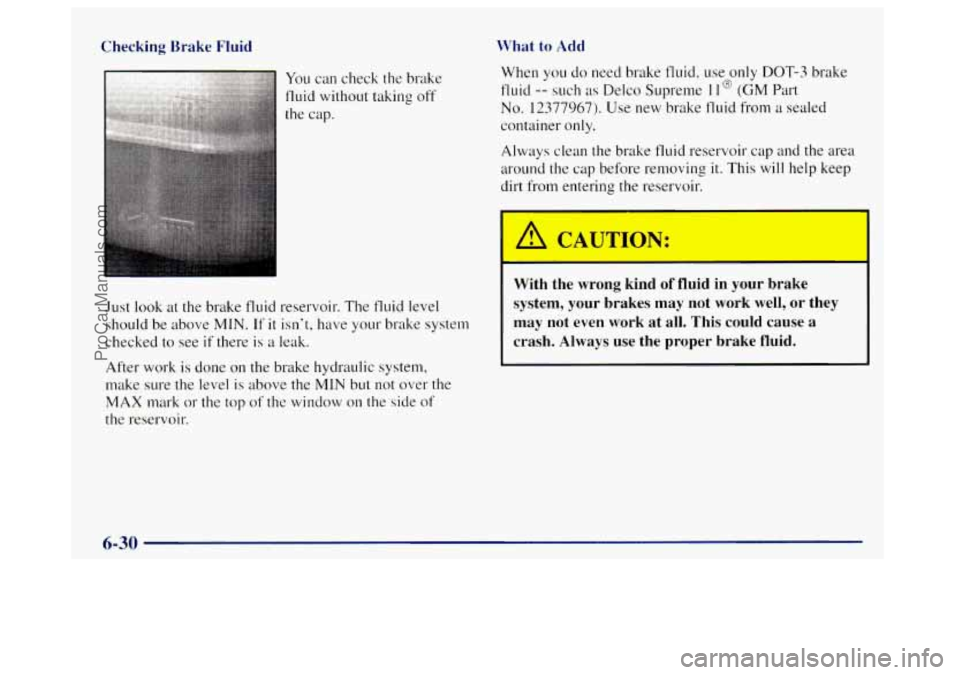
Checking Brake Fluid
Just look at the brake fluid reservoir. The fluid level
should be above
MIN. If it isn't, have your brake system
checked to see
if there is a leak.
After work
is done on the brake hydraulic system,
make sure the level is above the
MIN but not over the
MAX mark or the top of the window on the side of
the reservoir.
What to Add
When you do need brake fluid, use only DOT-3 brake
fluid
-- such as Delco Supreme 1 I@ (GM Part
No. 12377967). Use new brake fluid from a sealed
container only.
Always clean the brake fluid reservoir cap and the area
around the cap before removing
it. This will help keep
dirt from entering the reservoir.
With the wrong kind of fluid in your brake
system, your brakes may not work well, or they
may not even work at all. This could cause a
crash. Always use the proper brake fluid.
6-30
ProCarManuals.com
Page 286 of 380

NOTICE:
The wrong wheel can also cause problems with
bearing life, brake cooling, speedometer or
odometer calibration, headlamp aim, bumper
height, vehicle ground clearance and tire
clearance to the body and chassis.
See “Changing a Flat Tire” in the Index for
more information.
Used Replacement Wheels
/1 MI CP ““‘3N:
Putting a used wheel on your vehicle is
dangerous. You can’t know how it’s been used or
hotv
far it’s been driven. It could fail suddenly
and cause an accident.
If you have to replace a
wheel, use a new GM original equipment wheel.
Tire Chains
NOTICE:
______
Don’t use tire chains. They can damage your
vehicle because there’s not enough clearance.
Use another type of traction device only if its
manufacturer recommends it for use on your
vehicle and tire size combination and road
conditions. Follow that manufacturer’s
instructions. To help avoid damage to your
vehicle, drive slowly, readjust or remove the
device
if it’s contacting your vehicle, and don’t
spin your wheels.
Appearance Care
Remember, cleaning products can be hazardous. Some
are toxic. Others can burst into flame
if you strike a
match or get them on a hot part of the vehicle. Some are
dangerous if you breathe their fumes in a closed space.
When you use anything from a container to clean your
vehicle, be sure to follow the manufacturer’s warnings
and instructions. And always open your doors or
windows when you’re cleaning the inside.
ProCarManuals.com
Page 289 of 380
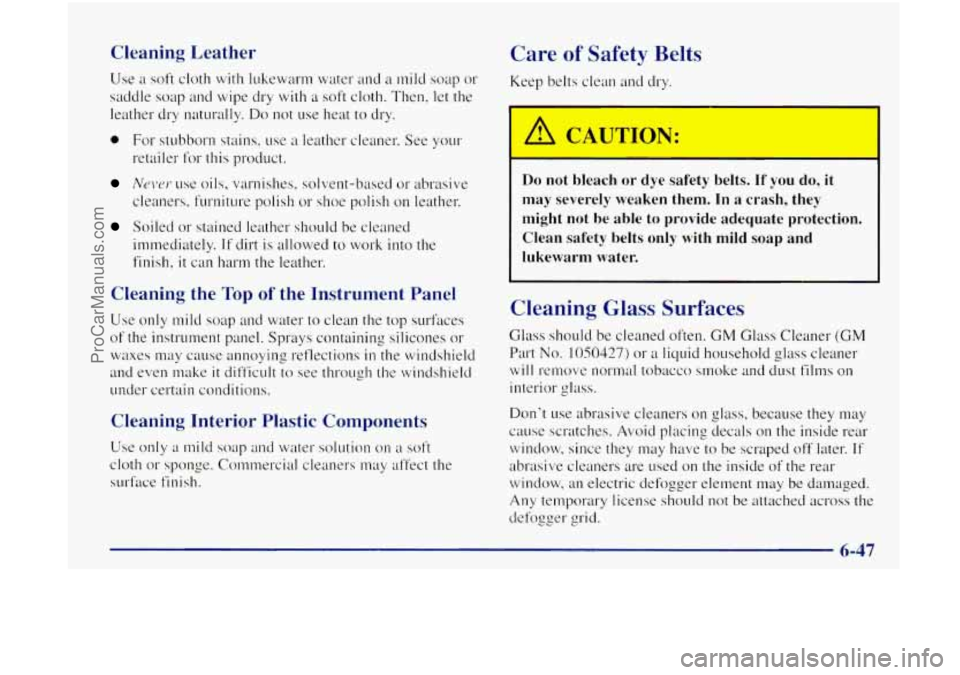
Cleaning Leather
Use a soft cloth with lukewarm water and a mild soap or
saddle soap and wipe dry
with a soft cloth. Then, let the
leather dry naturally.
Do not use heat to dry.
0 For stubborn stains. use a leather cleaner. See your
retailer for this product.
Ncwr use oils, varnishes? solvent-based or abrasive
cleaners. furniture polish or shoe polish
on leather.
Soiled or stained leather should be cleaned
immediately.
If dirt is allowed to work into the
finish. it can 11arm the leather.
Cleaning the Top of the Instrument Panel
Use only mild soap and water to clean the top surfaces
of the instrument panel. Sprays containing silicones or
waxes may cause annoying reflections
in the windshield
and even make
it difficult to see through the windshield
under certain conditions.
Cleaning Interior Plastic Components
Use only a mild soap and water solution on a soft
cloth or sponge. Comnlercial cleaners may affect the
surface finish.
Care of Safety Belts
Keep belts clean and dry.
I
A CAUTION:
Do not bleach!! dye safety belts. If you do, it
may severely weaken them. In
a crash, they
might not
be able to provide adequate protection.
Clean safety belts only with mild soap and
lukewarm water.
Cleaning Glass Surfaces
Glass should be cleaned often. GM Glass Cleaner (GM
Part
No. 1050427) or a liquid household glass cleaner
will remove normal tobacco smoke and dust films on
interior
glass.
Don't use abrasive cleaners on glass, because they may
cause scratches. Avoid placing decals
on the inside rear
window, since they may have to be scraped
off later. If
abrasive cleaners are used on the inside of the rear
window, an electric defogger element may be damaged.
Any temporary license should not be attached across the
defogger grid.
- 6-47
ProCarManuals.com
Page 296 of 380

Electrical System
Add-on Electrical Equipment
I NOTICE:
~ ~~~~~~
Don’t add anything electrical to your vehicle
unless you check with your retailer first. Some
electrical equipment can damage your vehicle
and the damage wouldn’t be covered by your
warranty. Some add-on electrical equipment can
keep other components from working as
they should.
Your vehicle has an air bag system. Before attempting to
add anything electrical to your vehicle. see “Servicing
Your Air Bag-Equipped Vehicle”
in the Index.
Headlamps
The headlamp wiring is protected by an internal circuit
breaker.
An electrical overload will cause the lamps to
go on and off. or in some cases to remain off. If this
happens, have your headlamp wiring checked
right away.
Windshield Wipers
The windshield wiper motor is protected by a circuit
breaker
and a fuse. If the motor overheats due to heavy
snow, etc.,
the wiper will stop until the motor cools. If
the overload is caused by some electrical problem, be
sure to get
it fixed.
Power Windows and Other Power Options
Circuit breakers protect the power windows and other
power accessories. When
the current load is too heavy,
the circuit breaker opens
and closes, protecting the
circuit
mtil the problem is fixed or goes away.
6-54
ProCarManuals.com
Page 298 of 380

FuseKircuit Usage
Breaker
A Not Used
B Not Used
1 Headlamp Switch, Body Control
Module, Headlamp Relay
FuseKircuit
Breaker
2
3
4
8
9
10
11
12
Usage
Cigarette Lighter, Data Link
Connector
Cruise Control Module and
Switch, Body Control Module,
Heated Seats
Gages, Body Control Module,
Instrument Panel Cluster
Interior Lights
Not Used Power Outside Mirror, Power
Lock Relay
Courtesy Lamps, Battery Run-Down Protection
HVAC Control Head (Manual)
Turn
Signal
Cluster, Engine Control Module Parking Lamps, Power Window
Switch, Body Control Module,
Ashtray Lamp
ProCarManuals.com
Page 301 of 380
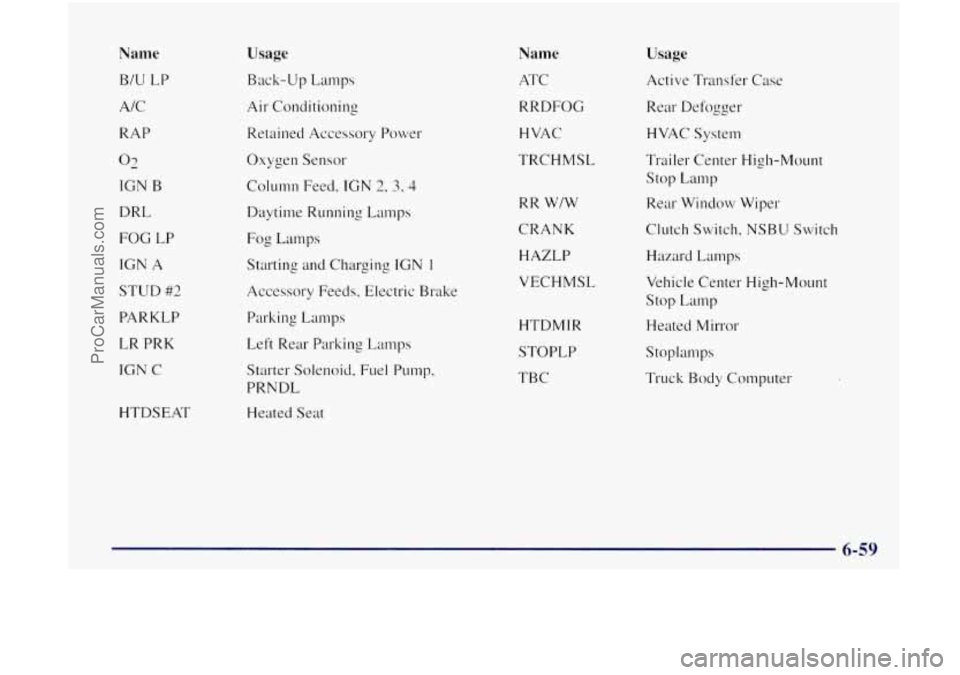
Name
BIU LP
AIC
RAP
02
IGN B
DRL
FOG LP
IGN
A
STUD #2
PARKLP
LR PRK
IGN C
HTDSEAT
Usage
Back-up Lamps
Air Conditioning
Retained Accessory Power
Oxygen Sensor
Column Feed,
IGN 2, 3, 4
Daytime Running Lamps
Fog Lamps
Starting and Charging
IGN 1
Accessory Feeds, Electric Brake
Parking Lamps
Left Rear Parking Lamps
Starter Solenoid. Fuel PLIIIIP,
PRNDL
Heated Seat
Name
ATC
RRDFOG
HVAC
TRCHMSL
RR WIW
CRANK HAZLP
VECHMSL
HTDMTR
STOPLP
TBC
Usage
Active Transfer Case
Rear Defogger HVAC System
Trailer Center High-Mount
stop Lamp
Rear Window Wiper
Clutch Switch, NSBU Switch
Hazard Lamps
Vehicle Center High-Mount
Stop Lamp
Heated Mirror
Stoplan1ps
Truck Body Computer
ProCarManuals.com
Page 368 of 380
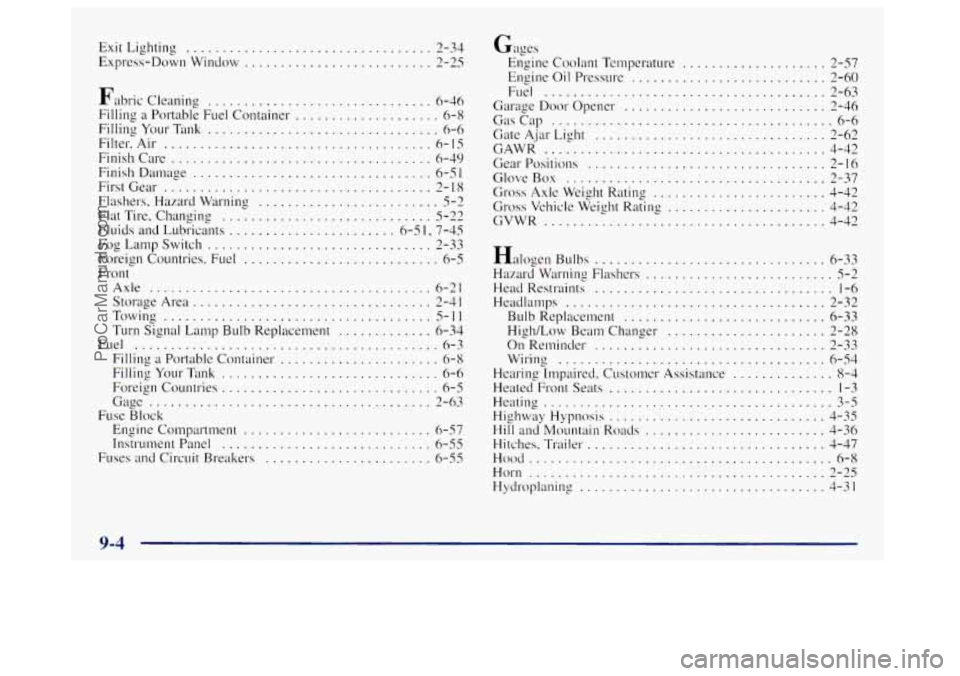
Exit Lighting .................................. 2-34
Express-Down Window
.......................... 2-25
Fabric Cleaning
............................... 6-46
Filling a Portable Fuel Container
.................... 6-8
Filling Your
Tank ................................ 6-6
Filter.
Air ..................................... 6-15
Finish Care
.................................... 6-49
Finish Damage
................................. 6-5 I
FirstGear ..................................... 2-18
Flashers. Hazard Warning
......................... 5-2
Flat Tire. Changing
............................. 5-22
Fluids and Lubricants
....................... 6-51. 7-45
FogLampSwitch
............................... 2-33
Foreign Countries. Fuel
........................... 6-5
Front
Axle ....................................... 6-21
Towing
..................................... 5-11
Turn Signal Lamp Bulb Replacement ............. 6-34
Fuel
.......................................... 6-3
Filling a Portable Container ...................... 6-8
Storage
Area
................................. 2-41
Filling Your Tank
.............................. 6-6
Foreign Countries
.............................. 6-5
Gage
....................................... 2-63
Engine Compartment .......................... 6-57
Instrument Panel
............................. 6-55
Fuses and Circuit Breakers ....................... 6-55
Fuse Block Gages
Engine Coolant Temperature
.................... 2-57
Engine Oil Pressure
........................... 2-60
Garage Door Opener
............................ 2-46
GasCap ....................................... 6-6
Gate
A-jar Light ................................ 2-62
GAWR
....................................... 4-42
Gear Positions
................................. 2-16
GloveBox
.................................... 2-37
Gross Axle Weight Rating
........................ 4-42
Gross Vehicle Weight Ratlng
...................... 4-42
Fuel
....................................... 2-63
GVWR
....................................... 4-42
Halogen Bulbs
................................ 6-33
Hazard Warning Flashers
.......................... 5-2
Bulb Replacement
............................ 6-33
High/Low Beam Changer
...................... 2-28
On Reminder
................................ 2-33
Wiring
..................................... 6-54
Hearing Impaired. Customer Assistance
.............. 8-4
Heated Front Seats ............................... 1-3
Heating ........................................ 3-5
Highway Hypnosis .............................. 4-35
Hill and Mountain
Roads ......................... 4-36
Hitches. Trailer
................................. 4-47
Hood .......................................... 6-8
Hydroplaning
.................................. 4-31
Head
Restraints ................................. 1-6
Headlamps
.................................... 2-32
Horn
......................................... 2-25
9-4
ProCarManuals.com